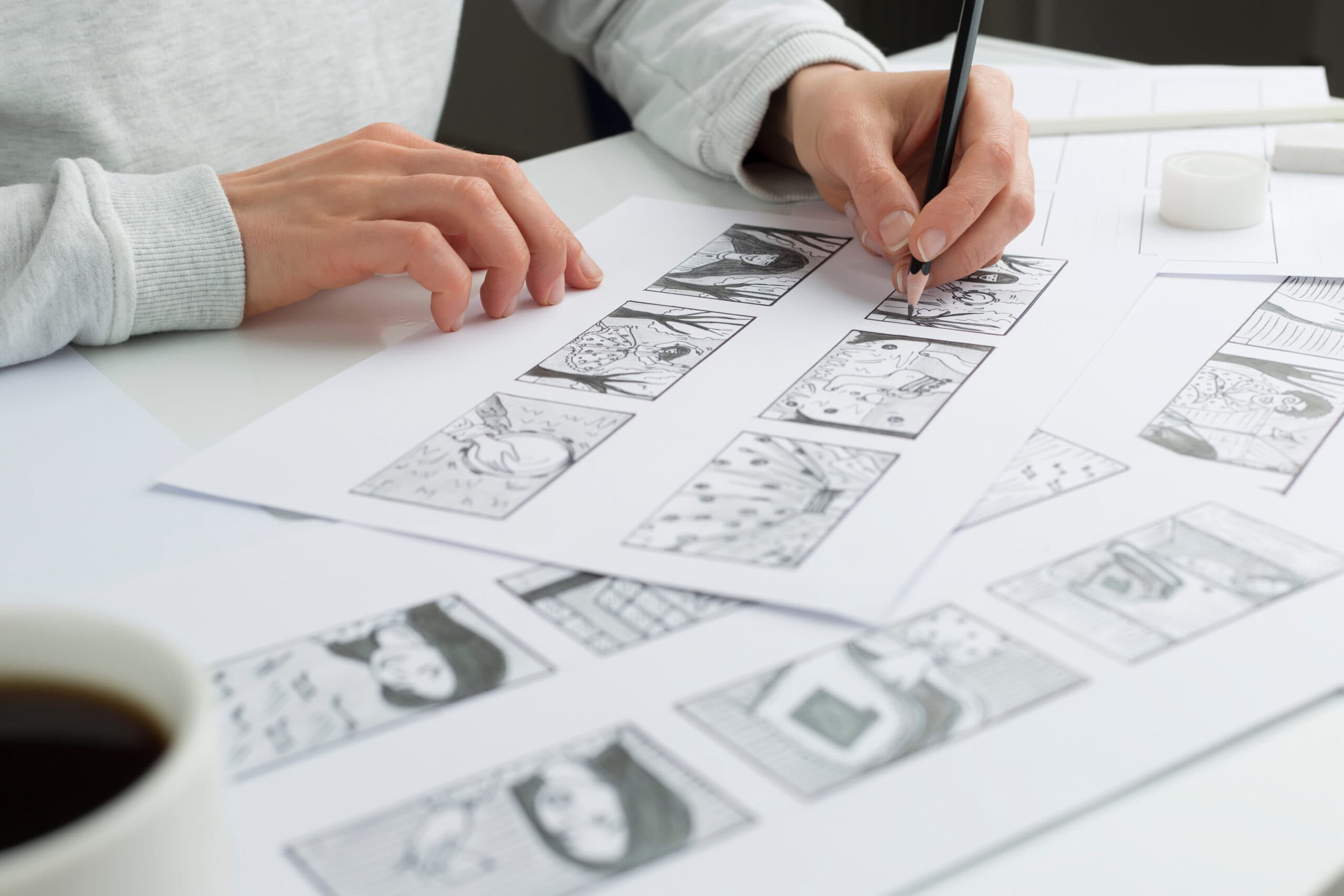Before you can begin creating an animated film, you will need to start with a storyboard, which allows you to develop a conceptual visualization of what the final product will look like. By drafting each frame composition, you and the rest of the animating team can make edits and develop a cohesive strategy for finalizing the animated feature.
The Essence of Storyboarding
Storyboarding is a critical part of the pre-production film process. Whether you are creating an animated feature or a live-action film, you will want to work with storyboard artists to create a frame-by-frame visualization of the film. At its core, storyboarding allows you to visualize the final concept and determine what changes need to be made before moving forward with the production.
What Is Storyboarding?
According to Filmmaker Tools, pre-production storyboarding is the art of creating a shot-by-shot representation of the film, and it’s particularly important when developing an animated feature. By defining the frame composition and perfecting the character positioning during the storyboarding process, you will be able to streamline the process of producing the film.
The History of Storyboarding
The history of storyboarding began with a man and a mouse — which is where a lot of our modern animated history begins. The modern art of storyboarding was developed by Walt Disney in the 1930s, when animated features were first being created. The first feature-length film to use animation storyboarding was Snow White and the Seven Dwarfs.
While animation was the first type of film to use storyboarding, it soon became clear that these techniques were useful in live-action films as well. It’s believed that Gone With the Wind was the first live-action film to rely on storyboarding.
Traditionally, storyboarding was completed with pencil and paper, but today, most storyboard artists use storyboard templates and digital storyboarding tools to complete their scene layout.
The Storyboarding Process
The storyboard process may vary based on the individual film that you are working on. Per the Daisie Blog, you will want to have a solid understanding of your film’s script before you begin working on any sequential art for the film.
Key Steps in Creating a Storyboard
The key steps in the storyboarding process include:
- Choosing your storyboard materials – As you are choosing materials, you will want to focus on function and efficiency rather than artistic medium. Storyboards are designed to be a rough sketch or outline of the film’s frames. You may prefer to work with traditional materials, such as pencil and paper, or digital storyboarding tools.
- Selecting a storyboard layout – Depending on the film you are working on, you may opt for a typical comic-strip style storyboard template, or you may prefer to work with a template that accommodates the wide panels of a film screen.
- Breaking down your script into key moments – This is where your familiarity with the script comes into play. Your storyboard should rely heavily on the script to identify pivotal moments in the film.
Tools of the Trade
Plenty of storyboard artists have their own set of tools that they prefer to work with. Some choose to stick with the storyboarding basics and rely only on pencil and paper to do the job. Others prefer advanced technology and find themselves exploring different digital storyboarding tools.
Some of the most common tools of the trade include:
- Adobe Photoshop
- StoryBoard Artist Studio
- Autodesk Sketchbook
- Pencil and paper
Components of an Effective Storyboard
Regardless of your approach to storyboarding, you will find that there are several key components that should be incorporated into any storyboard.
The key components of an effective storyboard include:
- Illustrations – The images in a storyboard allow you to visualize the story and convey your intention to others on the film team.
- Scene descriptions – These captions provide additional context to the illustration, filling in key details that will help bring the film to life.
- Shot sequences – The shot sequences show how the story will move forward.
- Timing – The storyboard should include the amount of time for each frame, as this will allow animators or filmmakers to carry out your vision.
- Notes and annotations – These components are critical to the rest of the production team, as they allow them to better develop the film.
Visual Storytelling Techniques
Visual storytelling rests at the heart of storyboarding. These visual storytelling techniques can help you create a more effective and impactful storyboard:
- Show emotion through your illustrations, rather than try to explain how the character in the shot might be feeling.
- Get creative when it comes to perspective. Showing the shot from a different angle can invoke a different range of emotions in the viewer.
- Prioritize sequential art. Creating a flow that aligns with the script will allow the filmmakers to create a cohesive and powerful film.
Annotating Your Storyboard
Annotating your storyboard allows you to include notes and feedback from other members of the production team, including the director or producer. Effective notes and annotations will provide further clarification, which can allow the production team to work better together as they finalize the film.
Storyboarding for Different Mediums
The purpose of storyboarding remains consistent from one medium to the next. That said, the approach that you use for storyboarding may vary based on the type of film you are working on.
Film and Television
Film and television storyboarding is a form of sequential art, with the primary purpose being to outline the sequence of events based on the script. Through storyboarding, directors and other members of the production team can identify the best camera angles, character positions, frame composition and scene transitions to bring the script to life.
Animation and Gaming
In the world of animation and gaming, storyboarding serves a slightly different purpose. Not only does it help with narrative development, but it is also used to improve the user experience. This is particularly true in gaming, when storyboarding can play a pivotal role in improving the overall functionality of a game.
Challenges in Storyboarding
Storyboarding is one of the first key steps in the pre-production process, which means that there are still a lot of fluid elements at play. Whether you are working to break down a script that keeps changing, or you are struggling to align your vision for the film with the director’s vision, you will find that there are always challenges in storyboarding that you need to work through.
Common Obstacles and Solutions
A few of the most common challenges in storyboarding include:
- Creating clear illustrations that align with the team’s vision for the film. To overcome this, try to start the process with a rough sketch. Know that your storyboard doesn’t have to be perfect, and you can always work on improving it throughout the process.
- Keeping the flow consistent throughout the entire storyboard. Some storyboard artists find that creating color sketches helps them to improve overall flow and consistency.
- Staying on deadline. It’s easy to get caught up in the details, but that can result in costly delays. When it comes to storyboarding, remember that functionality is more important than aesthetic.
Adapting to Various Directorial Styles
Storyboard artists often work with many different directors and production teams over the course of their career. What works well for one director may not work for another, so it can be difficult to adapt to various directorial styles. However, learning to accept constructive feedback and modify your approach to storyboarding based on the individual director will help you to become more resilient in this dynamic industry.
Tips and Best Practices
Like any art form, your storyboarding techniques will grow and develop over time. Understanding the best storyboarding practices, and how the job works, will allow you to become a powerful visual storyteller.
From Novice to Expert
You can quickly become an expert storyboard artist by:
- Knowing how the job works. Storyboard artists get paid by the frame, so it is best to learn to work quickly and efficiently.
- Prioritizing visual storytelling. It’s less about the illustrations themselves and more about how you can bring the script to life.
- Playing with camera angles in your storyboard. Your sketches should offer more than one perspective.
- Adding details to inspire the imagination. These details can add a lot of context to the film.
- Remaining receptive to feedback. Being able to adapt and be a team player will help you progress in your career as a storyboard artist.
Learning From the Masters
Experienced storyboard artists can provide you with expert guidance along the way. Many novice artists find that they benefit immensely from mentors, particularly those who have worked in the film industry for several years.
The Future of Storyboarding
As with any type of art, advancing technology is poised to redefine the future of storyboarding. Digital storyboarding tools are quickly replacing all traditional techniques, and it’s expected that new technology will continue to impact the world of storyboarding.
Emerging Trends and Technologies
Some of the emerging trends and technologies shaping the art of storyboarding include:
- Data-driven storyboarding – More and more storyboard artists are relying on market research and data harvesting to create more refined storyboards.
- Mobile storyboarding – An increasing number of film teams are working with mobile storyboarding apps, which allow everyone to collaborate remotely on the film.
The Role of VR and AR in Storyboarding
Virtual reality, augmented reality and machine learning will undoubtedly have a significant impact on the art of storyboarding soon. These impressive technologies now allow artists to visualize their storyboards in an immersive environment and test out their theories prior to moving forward with production.
Learn the Best Visual Storytelling Techniques at Rocky Mountain College of Art + Design
At Rocky Mountain College of Art + Design, we offer both in-person and online animation degree programs. Our Bachelor of Fine Arts in 2D Animation and Bachelor of Fine Arts in 3D Animation programs will not only teach you how to make a storyboard, but will also provide you with the skills needed to develop visual continuity in all of your animated works.
Request more information about our online degree programs today.

